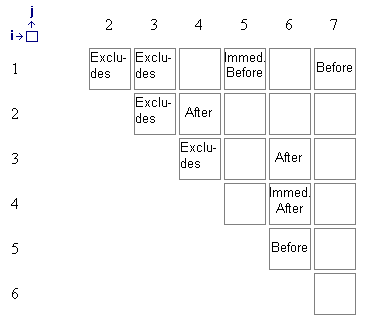DBTimes
Permissible Sequences of Events Generator
Problem definition
Relationship matrix
Problem definition
Module and demo description
Run Demo
Assume there is a set of n elements, we will call events, E = {e1 , e2 , , en }.
Definition 1. A sequence S is a subset of two or more events, where it can determined the order of occurrence for each pair of events -- event ei occurs before ej, if ei is earlier in the sequence than ej.
Assume also, that between each pair of events ( ei , ej ) could be defined one of the following order relationships:
- ( ei , ej ) = Before event ei occurs before ej (i.e., ei must be located earlier than ej in the sequence)
- ( ei , ej ) = Immediately Before event ei occurs immediately before ej (i.e., ei must be located right before ej in the sequence)
- ( ei , ej ) = After event ei occurs after ej (i.e., ei must be located later than ej in the sequence)
- ( ei , ej ) = Immediately After event ei occurs immediately after ej (i.e., ei located must be right after ej in the sequence)
- ( ei , ej ) = Not Dependent occurrence of event ei is not dependent on occurrence of ej (i.e., ei can be located earlier or later than ej in the sequence)
- ( ei , ej ) = Excludes event ei excludes ej (i.e., ei and ej cant exist in the same sequence).
All relationships are symmetric, i.e., the following is true:
· if ( ei , ej ) = Before , than ( ej , ei ) = After
· if ( ei , ej ) = Immediately Before, than ( ej , ei ) = Immediately After
· if ( ei , ej ) = After, than ( ej , ei ) = Before
· if ( ei , ej ) = Immediately After, than ( ej , ei ) = Immediately Before
· if ( ei , ej ) = Not Dependent, than ( ej , ei ) = Not Dependent
· if ( ei , ej ) = Excludes, than ( ej , ei ) = Excludes
Definition 2. A sequence is permissible, if it does not violate any of the defined order relationships.
Definition 3. Relationships between events are contradictory, if it is not possible to build a permissible sequence that includes these events. For example, the following relationships are contradictory: ( ei , ej ) = Before, ( ej , ek ) = Before, ( ei , ek ) = After .
The task is to find all permissible sequences given arbitrary, but not contradictory, order relationships between each pair of events.
We will represent event relationships as a triangular matrix, with cell (i, j) containing the relationship value for events ( ei , ej ). Because all relationships are symmetric and because the relationship with itself has no meaning, we will only consider relationships ( ei , ej ), i != j, i < j.
For example, the matrix for 7 events may look like this:
where X stands for Excludes, N - Not
Dependent, B - Before, A - After, IB
- Immediately Before, IA - Immediately After.
|
|
e1 |
e2 |
e3 |
e4 |
e5 |
e6 |
e7 |
|
e1 |
- |
X |
X |
N |
IB |
N |
B |
|
e2 |
- |
- |
X |
A |
N |
N |
N |
|
e3 |
- |
- |
- |
X |
N |
A |
N |
|
e4 |
- |
- |
- |
- |
N |
IA |
N |
|
e5 |
- |
- |
- |
- |
- |
B |
N |
|
e6 |
- |
- |
- |
- |
- |
- |
N |
|
e7 |
- |
- |
- |
- |
- |
- |
- |
The module to generate permissible sequences is written in C# as a .NET library. It generates sequences using Relationship Matrix as an input.
Run
Demo to see the module work using your own relationship
matrix.
Note, that Not Dependent relationship does not have any text in
the corresponding cell, e.g., the matrix for the one above will look like
this.
|
|
To enter order relationship for a pair of events
click on a square that corresponds to the pair. The relationship values
in the square will change with each click. For example, to enter Immediately Before
relationship, click on a square three times .
The ![]() diagram in the upper left corner
reminds that the vertical event is the first in the pair of events. For
example, Immediately Before relationship in the first row
means, "event 1 must occur immediately before event 5", and
After in the second row - "event 2 must
occur after event 4".
diagram in the upper left corner
reminds that the vertical event is the first in the pair of events. For
example, Immediately Before relationship in the first row
means, "event 1 must occur immediately before event 5", and
After in the second row - "event 2 must
occur after event 4".
